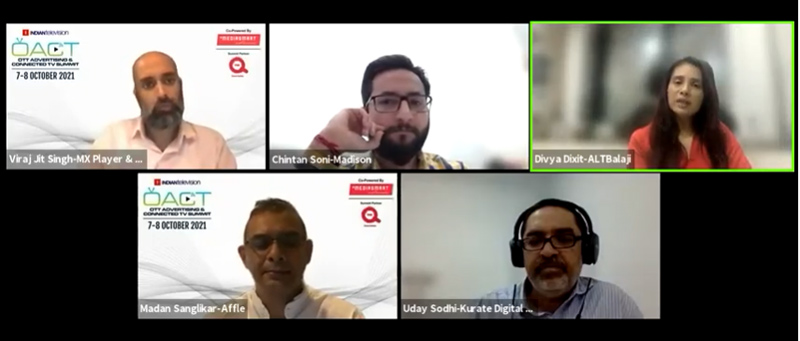Mumbai: The first session on day one of the OTT Advertising & Connected TV Summit 2021 saw Kurate Digital Consulting founder partner Uday Sodhi nudging the panel led by Madison VP-Digital products/performance Chintan Soni, ALTBalaji SVP - revenue and marketing Divya Dixit, Affle – co-founder, head- Agency Relation, chief of staff Madan Sanglikar, and MX Player and MX Takatak SVP head of revenue Viraj Jit Singh to share their understanding of the world of OTT & CTV advertising.
The two-day event being organised by Indiantelevision.com is co-powered by mediasmart, an Affle company and summit partner – The Q.
As the panellists addressed the fundamental question around synergies and distinctions between OTT and CTV on the buying and selling side of the business, the overarching insight that emerged was that the imminent CTV revolution is being powered by two engines – the OTT platforms and OEMs which bring together the software or the content and advertising solutions and the hardware or the affordability and technology, respectively, along with their individual contribution to the ad inventories.
Currently, there are about 500 million OTT users (including YouTube) in India. OTT platforms have played a crucial role in driving the content ecosystem with unique narratives. The pandemic further accelerated the rate, scale and quality of the content being delivered, as well as the mainstreaming of the medium. This has led to viewers looking for an enhanced experience of OTT offerings on smart TVs, most of which are more affordable than smartphones today.

According to Madison’s Q2 report, smart TV shipment grew by almost 65 per cent, claiming an 80 per cent share of the total TV shipments; their massive adoption being fuelled by starting price points as low as Rs 15,000.
Although the panel unanimously believed that both OTT and CTV will coexist in the future, some changes are inevitable. Divya Dixit observed that going forward “two parallel narratives of individualistic and inclusive viewing will emerge in the OTT space, with the growth in the latter driving certain genres of content.” In the context of evolving commerce, she stated, “As OTT platforms and OEMs grow their partnerships, they will evolve new business models, perhaps working on revenue sharing for content or on active marketing push, together.”
Sharing his understanding of viewership trends Viraj Jit Singh of MX Player and MX TakaTak said, “The last five years have seen a huge transition in user behaviour and experiences as they moved from linear to on-demand viewing, but what we are seeing now is a shift back to TV as the screen for consumption of OTT content due to the large screen experience it offers. So platforms like us are working on tech as well as programming to ensure that we have enough to offer a CTV consumer in the near future.”
From an advertising perspective, Singh shared that there’s significant demand for CTV, however, despite the reverse migration, he hasn’t come across any advertiser asking for separate measurement for CTV and OTT campaign impact yet. “We are still in the early days of CTV advertising and monetisation, though the expectation is that it will pick up from where mobile is today. The two platforms are different in terms of user behaviour such as time spent, length of viewing sessions, daypart and more importantly reach, with CTV targeting more than one person at any given time. Hence CTV advertising rates are higher, and also because marketers have a perception of the CTV audience being more premium than their mobile counterparts," he said.
According to Madison’s Chintan Soni, CTV advertising is nearly 2-2.5 times more expensive than purely mobile-based advertising, however as the pool size grows, efficiencies will be better.
There are 20-22 million MAU on CTV, and the segment is growing faster than HD which is at 40-44 million as per Madison’s monthly report. Soni believes that by 2024 these figures will be comparable.
Speaking in the context of advertising, and whether CTV will evolve its own ad ecosystem, he added, “Owing to its precision targeting capabilities and the immersive experience of the big screen CTV will be the ‘Next Big Unlock’. There will be a paradigm shift in the video advertising market wherein the KPIs and measurement will have to be changed. We cannot be measuring on regular metrics like CTR and VTR for CTV. A reach-frequency matrix or awareness/consideration score will be more apt for this platform.”
Affle’s Madan Sanglikar asserted that the combining of TV and mobile metrics will lead to much higher levels of measurability. Commenting on the nuances of CTV advertising and what it brings to the table, he said, “While all aspects of digital targeting are available with CTV, the next step is to interact with the user. Almost all studies done so far have indicated that people engage with more than one device at any given time, and this is to the benefit of advertisers. Even though the current ecosystem is dominated by app-first advertising, one of the ways is to re-target the ad to the mobile handset so that the user can engage with it after having viewed it on the big screen where they are less likely to click/swipe it away. This translates into the advantage of a larger approach coupled with an interactive experience.”
For more information: https://indiantelevision.com/events/oact-summit-2021/






